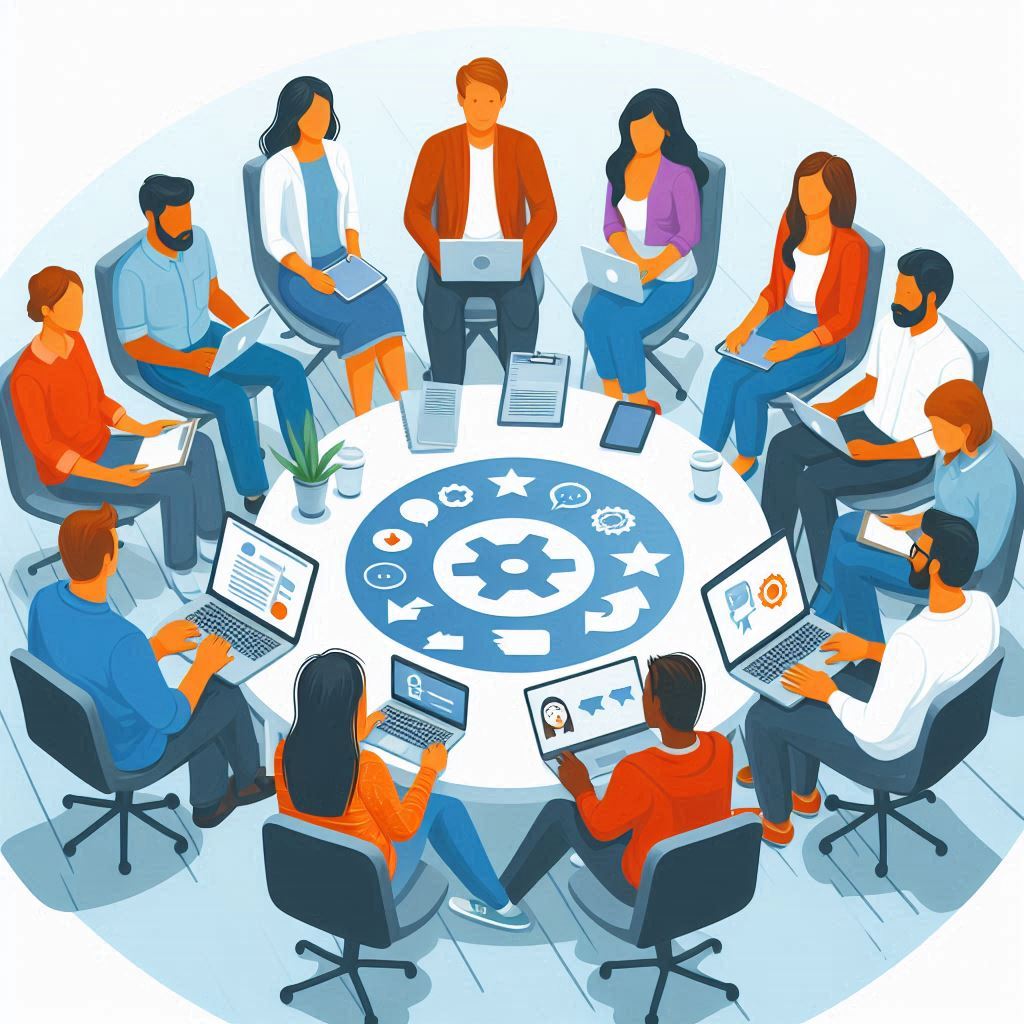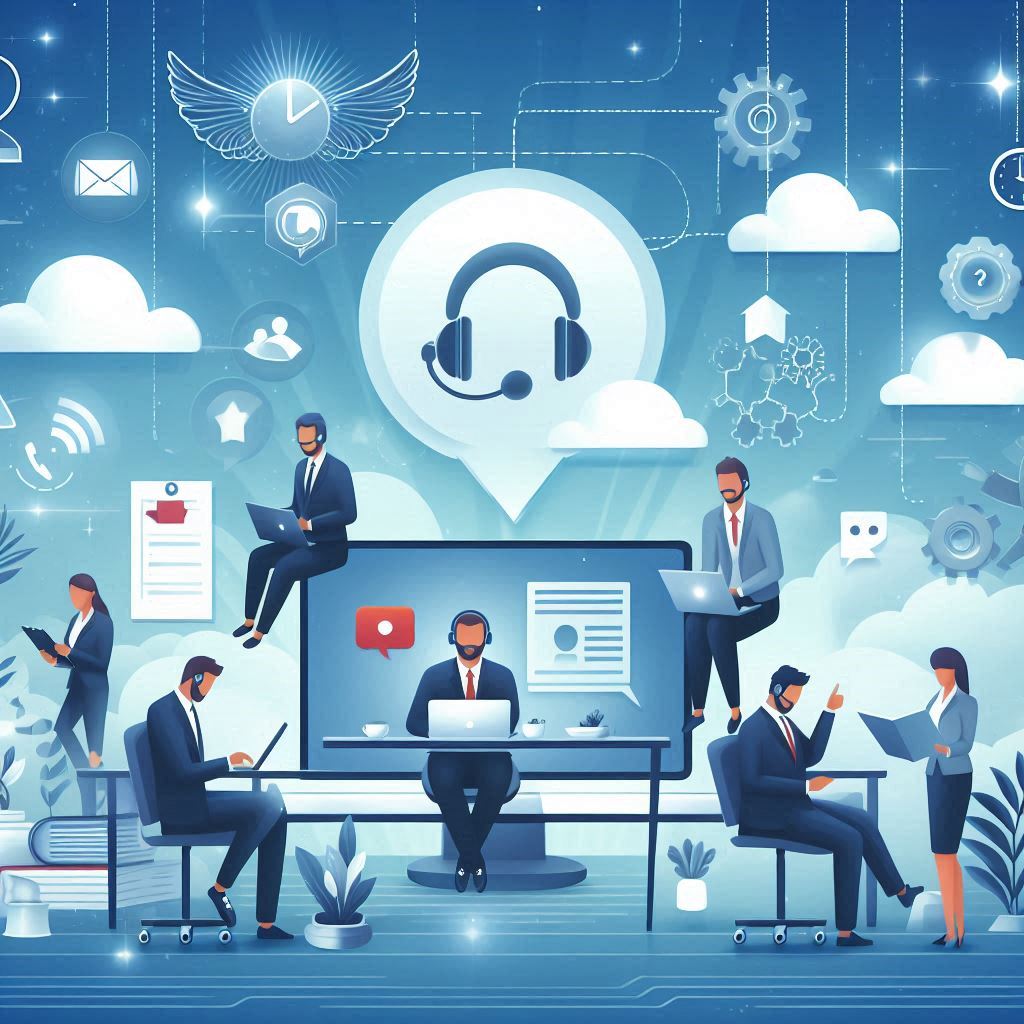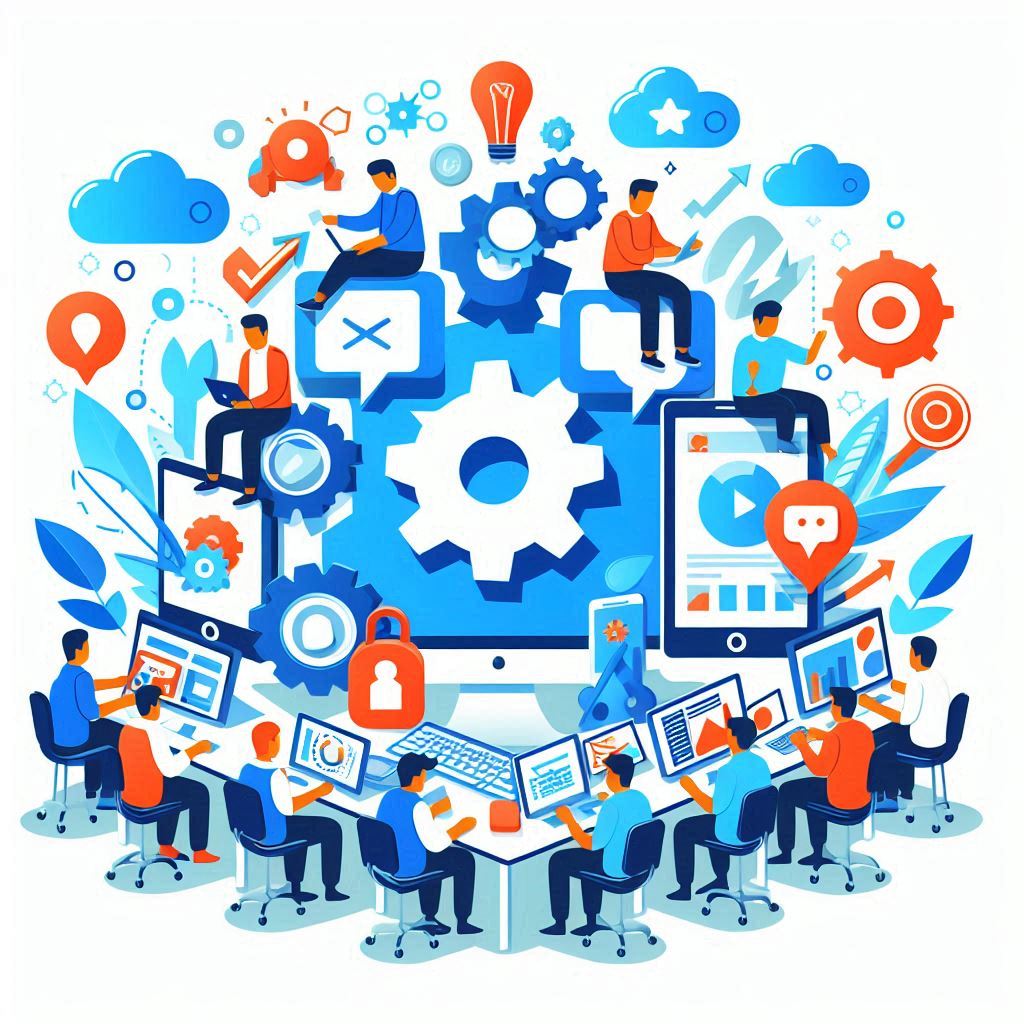How to Create Engaging User Interfaces for Software Applications Creating engaging user interfaces (UIs) for software applications is crucial for enhancing user experience (UX) and ensuring user satisfaction. A well-designed UI not only makes the application visually appealing but also facilitates ease of use, leading to increased user engagement and retention. This blog explores key principles and practices for designing engaging UIs for software applications. 1. Understand Your Users 1.1. Conduct User Research Understanding your target audience is fundamental to creating an engaging UI. Surveys and Interviews: Gather insights on user preferences, behaviors, and pain points through surveys and interviews. This will help you identify what users want and expect from your application. Personas: Develop user personas that represent different segments of your audience. These personas will guide your design decisions and help tailor the UI to meet their needs. 1.2. Define User Goals and Tasks Identify the primary goals users want to achieve with your software. Task Analysis: Break down the tasks users will perform within the application. Understanding these tasks will inform the layout and functionality of your UI. User Journey Mapping: Create user journey maps to visualize the steps users take when interacting with your application. This will help identify critical touchpoints and areas for improvement. 2. Emphasize Clarity and Simplicity 2.1. Minimalistic Design A clean and minimalistic design helps users focus on their tasks without distractions. Whitespace: Use ample whitespace to create a sense of balance and clarity in your UI. This makes it easier for users to process information and navigate the interface. Visual Hierarchy: Establish a clear visual hierarchy by using size, color, and spacing to guide users’ attention to the most important elements. 2.2. Intuitive Navigation A well-organized navigation structure is essential for an engaging UI. Consistent Layout: Maintain a consistent layout across different sections of the application to help users feel at ease while navigating. Descriptive Labels: Use clear and descriptive labels for navigation elements, ensuring users understand where each link or button will take them. 3. Incorporate Visual Elements 3.1. Effective Use of Colors Color plays a significant role in creating an engaging UI. Color Psychology: Choose colors that resonate with your brand and evoke the desired emotions. For example, blue often conveys trust, while green is associated with growth. Contrast: Ensure sufficient contrast between text and background colors to improve readability and accessibility. 3.2. Typography Matters Typography can significantly impact the overall feel of your application. Font Selection: Choose legible fonts that align with your brand identity. Limit the number of fonts to maintain consistency. Hierarchy: Use different font sizes and weights to establish a visual hierarchy, making it easier for users to scan content. 3.3. Imagery and Graphics Images and graphics can enhance the visual appeal of your UI. Relevant Visuals: Use images and icons that are relevant to the content and purpose of the application. Ensure they are of high quality and appropriately sized. Consistency: Maintain a consistent style for icons and images throughout the application to create a cohesive look. 4. Focus on Interaction Design 4.1. Responsive Feedback Providing users with immediate feedback enhances engagement and satisfaction. Visual Cues: Use visual cues (like button animations or loading indicators) to indicate when users interact with the interface, helping them understand that their actions have been recognized. Error Messages: Display clear and helpful error messages to guide users in resolving issues without frustration. 4.2. Microinteractions Microinteractions are subtle animations or design elements that improve user experience. Engaging Elements: Incorporate microinteractions for actions like button clicks, form submissions, and notifications to make the UI feel more dynamic and responsive. Delight Users: Use playful animations to delight users, such as animated progress bars or engaging transitions between screens. 5. Accessibility and Inclusivity 5.1. Design for All Users Creating an inclusive UI ensures that all users, including those with disabilities, can engage with your application. Accessibility Standards: Adhere to accessibility standards (like WCAG) to ensure your UI is usable for people with visual, auditory, or motor impairments. Keyboard Navigation: Ensure that all interactive elements are accessible via keyboard navigation, allowing users who cannot use a mouse to engage with the application. 5.2. Testing for Accessibility Conduct usability testing with diverse user groups to identify potential accessibility issues. User Feedback: Gather feedback from users with disabilities to understand their experiences and challenges when using your application. Iterative Improvements: Use the feedback to make iterative improvements to the UI, enhancing accessibility and usability for all users. 6. Iterate and Improve 6.1. Prototyping and Testing Creating prototypes allows you to test your design before full implementation. Wireframes: Develop wireframes to outline the structure and layout of your UI, allowing for early feedback and adjustments. User Testing: Conduct usability tests with real users to identify pain points and gather insights for improvement. 6.2. Continuous Feedback Loop Establish a continuous feedback loop to refine your UI over time. Analytics: Use analytics tools to monitor user behavior within your application, identifying areas where users may struggle or drop off. Regular Updates: Regularly update the UI based on user feedback and changing trends, ensuring the application remains engaging and relevant. 7. Conclusion Creating engaging user interfaces for software applications requires a deep understanding of user needs, a focus on clarity and simplicity, effective use of visual elements, and a commitment to accessibility. By incorporating these principles and continuously iterating based on user feedback, you can design UIs that not only captivate users but also enhance their overall experience. An engaging UI leads to higher user satisfaction, improved retention rates, and ultimately, the success of your software application in a competitive market.
The Importance of Customer Reviews in Software Marketing
The Importance of Customer Reviews in Software Marketing In today’s digital landscape, customer reviews have become an integral part of software marketing strategies. Potential users increasingly rely on reviews to make informed decisions about software products. This blog explores the significance of customer reviews in software marketing, their impact on consumer behavior, and strategies for leveraging reviews to enhance marketing efforts. 1. Understanding Customer Reviews Customer reviews are evaluations written by users about their experiences with a software product. They can appear on various platforms, including app stores, company websites, social media, and third-party review sites. These reviews often highlight users’ satisfaction, dissatisfaction, and suggestions for improvement. 2. The Role of Customer Reviews in Building Trust 2.1. Establishing Credibility In an era where consumers are inundated with choices, customer reviews serve as social proof, helping to establish the credibility of a software product. Authenticity: Potential users are more likely to trust the experiences of fellow users over promotional content from the software provider. Transparency: A mix of positive and negative reviews can convey authenticity, suggesting that the company is open about its product’s strengths and weaknesses. 2.2. Reducing Perceived Risk Investing in software often comes with inherent risks, such as financial commitment and potential disappointment. Informed Decisions: Customer reviews provide insights into the software’s performance and reliability, helping potential users feel more confident in their purchase decisions. User Experiences: Positive reviews can alleviate concerns, encouraging potential customers to take the plunge. 3. Impact of Customer Reviews on Consumer Behavior 3.1. Influencing Purchase Decisions Research shows that a significant percentage of consumers read reviews before making a purchase decision, especially for software products. Buying Cycle: Reviews can play a pivotal role in different stages of the buying cycle, from initial awareness to final purchase. Comparison: Customers often compare reviews from multiple sources to gauge the overall sentiment about a software product. 3.2. Affecting SEO and Online Visibility Customer reviews can also impact search engine optimization (SEO), enhancing a software product’s visibility online. User-Generated Content: Reviews contribute to user-generated content, which search engines prioritize, potentially improving search rankings. Local SEO: For software companies that serve specific regions, positive reviews can improve local search visibility and attract nearby customers. 4. Leveraging Customer Reviews in Marketing Strategies 4.1. Encouraging Reviews from Satisfied Customers To maximize the benefits of customer reviews, software companies should actively encourage satisfied customers to leave feedback. Post-Purchase Follow-Up: Send follow-up emails after a purchase, thanking customers and inviting them to share their experiences. Incentives: Consider offering incentives, such as discounts or exclusive content, to motivate users to leave reviews. 4.2. Showcasing Reviews in Marketing Materials Highlighting customer reviews in marketing materials can enhance credibility and attract new users. Testimonials: Use positive reviews as testimonials in promotional content, such as website banners, social media posts, and email newsletters. Case Studies: Develop case studies based on detailed customer experiences to showcase how the software has solved real-world problems. 4.3. Engaging with Reviewers Responding to customer reviews, both positive and negative, can demonstrate a commitment to customer satisfaction. Acknowledgment: Thank customers for their positive feedback, reinforcing their satisfaction. Resolution: Address negative reviews professionally and constructively, showing potential customers that the company values feedback and is willing to improve. 5. Addressing Negative Reviews 5.1. Learning Opportunities Negative reviews, while challenging, can provide valuable insights for software companies. Identify Pain Points: Analyzing negative feedback can help identify recurring issues, guiding future updates and improvements. Enhance Customer Experience: Use constructive criticism to enhance user experience, addressing gaps in the software that may hinder satisfaction. 5.2. Crisis Management How a company responds to negative reviews can significantly impact its reputation. Timely Responses: Address negative reviews promptly, demonstrating that the company cares about its customers. Offer Solutions: Provide solutions or remedies to dissatisfied customers, showing a willingness to make amends and improve. 6. The Future of Customer Reviews in Software Marketing 6.1. Trends in Review Platforms As technology evolves, so too do the platforms for customer reviews. Video Reviews: The rise of video content means that video reviews can provide a more dynamic and engaging way for users to share their experiences. AI and Automation: Leveraging AI can help analyze reviews more efficiently, providing insights into customer sentiments and preferences. 6.2. Integrating Reviews into User Experience Incorporating reviews directly into the software experience can enhance user engagement and satisfaction. In-App Reviews: Allow users to leave reviews directly within the app, making it easier for them to provide feedback. User Rating Systems: Implement user rating systems that allow customers to rate features or aspects of the software, providing quick insights into strengths and weaknesses. 7. Conclusion Customer reviews play a crucial role in software marketing, influencing consumer behavior and establishing trust. By actively encouraging, showcasing, and engaging with reviews, software companies can harness the power of customer feedback to enhance their marketing strategies. Addressing negative reviews thoughtfully can turn challenges into opportunities for improvement. As technology continues to evolve, staying abreast of trends in customer reviews will be essential for software companies aiming to maintain a competitive edge in the market. Embracing customer feedback not only drives marketing success but also fosters a culture of continuous improvement and customer-centricity.
How to Optimize Software for Mobile Users
How to Optimize Software for Mobile Users As mobile device usage continues to soar, optimizing software for mobile users has become essential for enhancing user experience and driving engagement. Whether you’re developing a web application or a mobile app, ensuring your software performs seamlessly on mobile devices is critical. This blog discusses best practices for optimizing software for mobile users, focusing on design, performance, and usability. 1. Understand Your Mobile User Base 1.1. Analyze User Behavior Before optimizing your software for mobile, it’s crucial to understand how your users interact with mobile devices. Analytics Tools: Use analytics tools like Google Analytics or Mixpanel to gather data on user demographics, behavior, and device types. User Feedback: Collect feedback from mobile users to understand their preferences and pain points. 1.2. Define Use Cases Identify the primary use cases for your mobile software. Consider how users will interact with your software on smaller screens and in various contexts. Task Prioritization: Determine the most critical tasks users need to accomplish on mobile and ensure these tasks are easy to access. 2. Responsive Design 2.1. Implement a Responsive Layout A responsive design adapts to different screen sizes, ensuring a seamless experience across devices. Fluid Grids: Use fluid grids that adjust element sizes based on the screen dimensions, allowing for flexible layouts. Media Queries: Implement CSS media queries to change styles based on screen size, orientation, and resolution. 2.2. Optimize Touch Targets Mobile users rely on touch screens, so it’s vital to ensure that interactive elements are easy to use. Size and Spacing: Make touch targets large enough (at least 44×44 pixels) and provide ample spacing between them to prevent accidental clicks. Gestures: Utilize common gestures (like swiping and pinching) to enhance navigation and interactions. 3. Performance Optimization 3.1. Reduce Load Times Mobile users expect fast-loading software. Aim to minimize load times to enhance user experience. Image Optimization: Compress images and use appropriate formats (like WebP) to reduce file sizes without sacrificing quality. Minimize HTTP Requests: Limit the number of requests made to the server by combining files (like CSS and JavaScript) and using CSS sprites for images. 3.2. Optimize Code and Assets Keep your codebase clean and efficient to improve performance. Code Minification: Minify HTML, CSS, and JavaScript files to reduce file sizes and improve loading speed. Lazy Loading: Implement lazy loading for images and other assets, loading only what is necessary when the user scrolls. 4. User Interface (UI) and User Experience (UX) Design 4.1. Prioritize Simplicity Mobile interfaces should be simple and intuitive, allowing users to navigate easily. Clear Navigation: Use a straightforward navigation structure, with clear labels and icons. Consider implementing a hamburger menu for additional options without cluttering the screen. Minimalistic Design: Focus on essential features and eliminate unnecessary elements that can overwhelm users. 4.2. Optimize Forms for Mobile Forms are a critical part of many applications, and optimizing them for mobile users can enhance usability. Input Types: Use appropriate input types (like email and number) to enable mobile keyboards that suit the required data format. Auto-Fill: Enable auto-fill options for fields to streamline the process and reduce user effort. 5. Testing and Iteration 5.1. Conduct User Testing Regularly test your mobile software with real users to gather feedback and identify areas for improvement. A/B Testing: Conduct A/B tests on different designs and features to determine what resonates best with your users. Usability Testing: Observe users as they interact with your software to pinpoint usability issues and gather insights for enhancements. 5.2. Use Mobile Emulators and Real Devices Test your software on both emulators and real devices to ensure compatibility across different platforms and screen sizes. Cross-Device Testing: Use tools like BrowserStack or Sauce Labs to test your application on various devices and browsers. Real-World Scenarios: Test under real-world conditions (e.g., different network speeds) to understand how your software performs in various environments. 6. Implementing Mobile-Specific Features 6.1. Geolocation Services Utilizing geolocation can enhance the user experience by providing location-based services. Personalization: Offer personalized content or features based on the user’s location, improving relevance and engagement. Maps and Directions: Integrate mapping services for applications that require navigation or location information. 6.2. Push Notifications Engage mobile users through timely and relevant push notifications. User Preferences: Allow users to customize their notification preferences to enhance their experience without overwhelming them. Targeted Messaging: Use analytics to send targeted messages based on user behavior and preferences. 7. Conclusion Optimizing software for mobile users is essential for meeting the demands of today’s digital landscape. By understanding user behavior, implementing responsive design, optimizing performance, focusing on UI/UX, and continuously testing and iterating, you can create a mobile experience that delights users and drives engagement. Embracing these best practices will not only enhance user satisfaction but also position your software for success in a competitive marketplace. As mobile technology continues to evolve, staying ahead of trends and user expectations will be key to achieving long-term success.
Understanding the Customer’s Role in Software Innovation
Understanding the Customer’s Role in Software Innovation In today’s competitive software landscape, customer involvement has become a crucial component of innovation. Customers are no longer passive recipients of products; they are active participants in the software development process. This blog explores the various ways customers contribute to software innovation, the benefits of their involvement, and strategies for fostering collaboration between customers and development teams. 1. The Evolving Role of Customers in Software Development 1.1. From Passive Users to Active Contributors Historically, software development followed a top-down approach where developers created products based on their assumptions about user needs. However, with the rise of agile methodologies and customer-centric design, customers are now viewed as vital contributors to the development process. Feedback Loops: Customers provide feedback during various stages of development, influencing design choices and feature prioritization. Co-Creation: Some organizations invite customers to participate in co-creation workshops, where they collaborate with developers to generate ideas and solutions. 1.2. The Impact of Digital Tools The advent of digital tools has transformed how customers engage with software development. User Testing Platforms: Tools like UserTesting and Lookback allow customers to test software and provide feedback in real-time. Social Media and Forums: Online platforms enable customers to share their experiences, preferences, and pain points, which can inform development efforts. 2. Benefits of Customer Involvement in Innovation 2.1. Enhanced Product Relevance Involving customers in the development process ensures that the final product aligns with their needs and expectations. Needs Identification: Customers can articulate their challenges, helping developers understand the specific problems they aim to solve. Feature Prioritization: Customer feedback aids in prioritizing features that provide the most value, ensuring that the software meets user demands. 2.2. Increased User Adoption When customers are involved in the innovation process, they are more likely to feel a sense of ownership over the product. Familiarity: Customers who participate in development become familiar with the product, easing the transition from development to actual use. Advocacy: Satisfied customers are more likely to advocate for the product, leading to positive word-of-mouth and increased adoption rates. 2.3. Rapid Iteration and Improvement Customer involvement allows for quicker iterations based on real-time feedback. Agile Development: In an agile framework, feedback is gathered continuously, allowing for rapid adjustments and improvements. Minimized Risk: Early identification of potential issues reduces the risk of major failures post-launch, saving time and resources. 3. Strategies for Engaging Customers in Innovation 3.1. Establish Clear Communication Channels Creating effective communication channels facilitates collaboration between customers and development teams. Regular Updates: Keep customers informed about development progress and solicit their feedback at various stages. Dedicated Platforms: Utilize customer forums or feedback tools to allow users to share their insights and experiences. 3.2. Conduct Customer Workshops and Focus Groups Organizing workshops and focus groups can provide deeper insights into customer needs and expectations. Brainstorming Sessions: Invite customers to brainstorm new ideas and features, encouraging collaborative thinking. Usability Testing: Conduct usability tests to observe how customers interact with the software and identify areas for improvement. 3.3. Implement Feedback Mechanisms Establish structured processes for gathering and implementing customer feedback. Surveys and Polls: Use surveys to gather quantitative data on customer preferences and satisfaction. Feedback Loops: Create mechanisms for continuous feedback, allowing customers to share their experiences even after the product is launched. 4. Case Studies of Successful Customer-Driven Innovation 4.1. Example 1: Slack Slack, a popular communication tool, actively involves its users in the innovation process through regular feedback and community engagement. Feedback Channels: The company encourages users to submit feature requests and provides a transparent roadmap for upcoming features. Community Input: Slack’s community actively contributes to the development of new functionalities, making the platform more user-friendly and relevant. 4.2. Example 2: Dropbox Dropbox employs a customer-centric approach by engaging users in testing new features before their official release. Beta Testing Programs: Users can sign up for beta testing, providing feedback that informs the final product. User Feedback Forums: The company actively listens to user feedback through forums, allowing customers to influence product development. 5. Challenges of Customer Involvement in Innovation 5.1. Balancing Diverse Opinions While customer feedback is valuable, managing diverse opinions can be challenging. Prioritization: Development teams must prioritize feedback based on feasibility and alignment with the overall product vision. Conflict Resolution: Teams should have strategies in place to handle conflicting feedback and ensure that decisions are made in the best interest of the user base. 5.2. Maintaining Control Over the Development Process Excessive customer involvement can lead to scope creep, where new ideas continuously alter the development roadmap. Setting Boundaries: Clearly define the scope of customer involvement to maintain focus on core objectives. Managing Expectations: Communicate to customers the limitations of their feedback and how it will be implemented. 6. Conclusion The role of customers in software innovation has evolved significantly, transforming them from passive users into active contributors in the development process. By engaging customers effectively, organizations can enhance product relevance, increase user adoption, and drive rapid iterations. Establishing clear communication channels, conducting workshops, and implementing feedback mechanisms are vital strategies for fostering collaboration between customers and development teams. Embracing this customer-centric approach not only leads to better products but also strengthens relationships, paving the way for ongoing innovation and success in the competitive software landscape.
How to Improve Communication Between Development and Customer Support
How to Improve Communication Between Development and Customer Support In today’s fast-paced digital environment, effective communication between development and customer support teams is essential for delivering high-quality software and ensuring customer satisfaction. Both teams play critical roles in the product lifecycle, yet their perspectives and priorities often differ. This blog outlines strategies to enhance communication between development and customer support, fostering collaboration and improving the overall customer experience. 1. Understanding the Importance of Communication 1.1. Why Communication Matters Effective communication between development and customer support teams leads to a better understanding of customer needs, quicker issue resolution, and improved product quality. When both teams collaborate effectively, they can: Identify and Address Issues Promptly: Rapid communication helps in identifying and resolving bugs and user concerns more efficiently. Align on Customer Expectations: Development teams gain insights into customer needs, while support teams stay informed about upcoming features and changes. 1.2. Common Communication Barriers Several challenges can hinder effective communication between these teams: Different Priorities: Development may focus on new features and enhancements, while support prioritizes resolving customer issues. Lack of Shared Knowledge: Teams may not be aware of each other’s processes, tools, and terminology, leading to misunderstandings. 2. Establishing Clear Communication Channels 2.1. Define Communication Tools Implement tools that facilitate communication and collaboration between development and customer support. Project Management Software: Use tools like Jira, Trello, or Asana to track tasks, bugs, and feature requests, ensuring transparency and accountability. Real-Time Communication Platforms: Utilize platforms like Slack or Microsoft Teams for instant messaging, allowing for quick discussions and updates. 2.2. Create Dedicated Communication Spaces Establish dedicated channels for discussions between teams. Regular Meetings: Schedule regular cross-functional meetings to discuss ongoing projects, customer feedback, and potential issues. Discussion Forums: Create forums or channels where team members can post questions, share insights, and collaborate on solutions. 3. Encouraging Collaboration Through Joint Initiatives 3.1. Cross-Functional Teams Form cross-functional teams that include members from both development and customer support. Collaborative Projects: Involve both teams in projects where their expertise is required, such as developing new features or improving existing ones based on customer feedback. Shared Goals: Set common objectives that emphasize the importance of collaboration, such as improving customer satisfaction scores. 3.2. Joint Training Sessions Conduct joint training sessions to build understanding and empathy between teams. Product Training: Organize sessions where development shares insights about new features and technical aspects with customer support. Customer Interaction Training: Provide development teams with training on customer interaction and support processes to enhance their understanding of customer needs. 4. Implementing Feedback Loops 4.1. Establish a Feedback Mechanism Create a structured process for sharing feedback between customer support and development teams. Regular Feedback Reports: Customer support can compile feedback from customers and share it with the development team in regular reports. User Stories and Use Cases: Encourage support to document user stories that highlight real customer experiences, helping developers understand context and needs. 4.2. Prioritize Feedback Implementation Prioritize addressing feedback from customer support in the development process. Feedback Review Meetings: Hold regular meetings to review customer feedback and determine which issues should be prioritized in upcoming development cycles. Track Progress: Use project management tools to track the status of feedback implementation, ensuring accountability and transparency. 5. Encouraging a Culture of Empathy and Understanding 5.1. Foster a Customer-Centric Mindset Encourage both teams to adopt a customer-centric approach to their work. Customer Stories: Share customer success stories and challenges with both teams to create a deeper understanding of customer needs and expectations. User-Centric Goals: Align team goals with customer outcomes, emphasizing the importance of delivering value to users. 5.2. Celebrate Collaborative Successes Recognize and celebrate instances of successful collaboration between development and customer support. Acknowledgment of Contributions: Publicly acknowledge team members who contribute to successful cross-team initiatives, reinforcing the importance of collaboration. Shared Success Metrics: Track and celebrate shared metrics, such as improved customer satisfaction scores or reduced issue resolution times, as a result of effective communication. 6. Measuring the Impact of Improved Communication 6.1. Track Key Performance Indicators (KPIs) Establish KPIs to measure the effectiveness of communication between development and customer support. Response Times: Monitor how quickly customer support can resolve issues with the information provided by the development team. Customer Satisfaction Scores: Analyze changes in customer satisfaction scores to gauge the impact of improved communication and collaboration. 6.2. Regularly Review and Adjust Strategies Conduct regular reviews of communication processes and strategies. Feedback Surveys: Gather feedback from both teams on communication effectiveness and areas for improvement. Iterative Improvements: Be open to adjusting communication strategies based on feedback and changing needs. 7. Conclusion Improving communication between development and customer support is vital for delivering high-quality software and enhancing the customer experience. By establishing clear communication channels, encouraging collaboration through joint initiatives, implementing feedback loops, and fostering a culture of empathy, organizations can bridge the gap between these critical teams. The result is a more cohesive approach to software development that prioritizes customer needs, leading to greater satisfaction and loyalty. Embracing effective communication not only benefits the teams involved but ultimately enhances the overall success of the product in the market.
The Role of Beta Testing in Software Development
The Role of Beta Testing in Software Development In software development, the journey from an idea to a fully functional product involves multiple stages, with beta testing being a critical phase. Beta testing allows developers to gather real-world feedback from actual users before launching the final product. This blog explores the significance of beta testing in the software development lifecycle, its benefits, best practices, and its impact on overall product success. 1. Understanding Beta Testing 1.1. Definition of Beta Testing Beta testing is the second phase of software testing, where a product is released to a limited number of users outside the development team. The goal is to identify bugs, gather feedback on functionality, and assess user experience in a real-world environment. This phase follows alpha testing, which is typically conducted internally. 1.2. Types of Beta Testing Closed Beta Testing: Limited to a specific group of users, often selected based on demographic or professional criteria. Feedback is collected from these participants to make necessary improvements. Open Beta Testing: Available to a broader audience, allowing anyone interested to participate. This approach provides a larger sample size and diverse feedback. 2. The Importance of Beta Testing in Software Development 2.1. Identifying Bugs and Issues One of the primary goals of beta testing is to uncover bugs and issues that were not identified during earlier testing phases. Real-World Usage: Beta testers use the software in real-world conditions, revealing unexpected problems that can occur outside the controlled environment of alpha testing. Diverse User Scenarios: Different users bring unique perspectives, identifying issues related to specific use cases, devices, or environments. 2.2. Gathering User Feedback Beta testing is crucial for gathering valuable user feedback on various aspects of the software. User Experience Insights: Beta testers provide feedback on usability, design, and functionality, helping developers understand how users interact with the software. Feature Validation: Gathering input on new features allows developers to determine which elements are valuable to users and which may need revision or removal. 2.3. Building User Trust and Engagement Engaging users during the beta testing phase can foster trust and loyalty to the brand. User Involvement: Allowing users to participate in the testing process makes them feel valued, increasing their investment in the product. Community Building: Beta testing can create a sense of community among users, encouraging them to provide feedback and share their experiences. 3. Best Practices for Effective Beta Testing 3.1. Define Clear Objectives Establish clear goals and objectives for the beta testing phase. Specific Areas of Focus: Identify the aspects of the software that need testing, such as functionality, usability, performance, or security. Target Audience: Define the target audience for beta testing to ensure that feedback is relevant and actionable. 3.2. Select the Right Beta Testers Choosing the right participants is crucial for gathering meaningful feedback. Diverse Representation: Include users from various demographics and backgrounds to capture a wide range of perspectives. User Profiles: Consider selecting users based on specific profiles that match your target audience for the final product. 3.3. Provide Clear Instructions Ensure that beta testers understand their roles and responsibilities. Guidelines for Testing: Provide detailed instructions on how to use the software and what specific areas to focus on during testing. Feedback Channels: Establish clear channels for submitting feedback, whether through surveys, forums, or direct communication. 4. Collecting and Analyzing Feedback 4.1. Use Feedback Tools Utilize various tools to collect and manage feedback efficiently. Surveys and Questionnaires: Create structured surveys to gather quantitative and qualitative feedback from beta testers. Bug Tracking Software: Implement bug tracking tools to organize and prioritize reported issues. 4.2. Analyze Feedback Effectively Analyzing feedback is essential for making informed decisions about product improvements. Categorization: Group feedback into categories, such as bugs, usability issues, and feature requests, to identify trends and prioritize actions. Prioritization: Determine which issues are most critical to address before the official release based on the severity and frequency of reported problems. 5. Making Improvements Based on Beta Testing 5.1. Iterate and Refine the Product Use the insights gained from beta testing to make necessary improvements to the software. Addressing Bugs: Fix critical bugs and issues identified during the testing phase to ensure a smoother user experience. Feature Adjustments: Modify or remove features that received negative feedback, or enhance those that users found valuable. 5.2. Communicate Changes to Beta Testers Keep beta testers informed about the changes made based on their feedback. Feedback Loop: Acknowledge and thank beta testers for their contributions, sharing how their feedback influenced the product’s development. Future Involvement: Encourage beta testers to continue engaging with the brand, fostering a community of loyal users. 6. The Impact of Beta Testing on Product Success 6.1. Improved Product Quality Effective beta testing leads to higher-quality software by identifying and addressing issues before the official launch. Enhanced User Experience: A well-tested product is more likely to meet user expectations, resulting in higher satisfaction and lower churn rates. Reduced Support Costs: Addressing bugs and usability issues during beta testing can minimize support requests post-launch, saving time and resources. 6.2. Increased Market Readiness Beta testing helps ensure that the product is ready for the market. Validation of Features: Feedback from beta testers validates the product’s features and ensures they align with user needs and expectations. Risk Mitigation: Identifying potential issues early in the development process reduces the risk of negative user experiences after launch. 7. Conclusion Beta testing is an invaluable phase in software development that plays a critical role in ensuring product quality, enhancing user experience, and fostering user engagement. By establishing clear objectives, selecting the right beta testers, collecting and analyzing feedback effectively, and iterating based on insights, developers can create software that meets user needs and expectations. As the software landscape continues to evolve, incorporating beta testing into the development process will remain essential for delivering successful products that resonate with users and stand out in the market.
How to Create a Culture of User Feedback in Software Development
How to Create a Culture of User Feedback in Software Development In today’s fast-paced digital landscape, developing software that meets user needs is more critical than ever. A culture of user feedback fosters continuous improvement and innovation, leading to products that resonate with users. This blog explores strategies to cultivate a user feedback culture in software development, ensuring that user voices are heard and integrated into every stage of the development process. 1. Understanding the Importance of User Feedback 1.1. Definition of User Feedback User feedback encompasses insights and opinions gathered from users about their experiences with a product. This feedback can come in various forms, including surveys, reviews, interviews, and usability tests. 1.2. Benefits of User Feedback in Software Development Enhanced User Experience: Regular feedback helps identify pain points and areas for improvement, leading to a better user experience. Informed Decision-Making: Feedback provides valuable insights that guide product development decisions, reducing the risk of developing features that do not meet user needs. Increased Customer Loyalty: When users feel their opinions are valued, they are more likely to remain loyal to the brand and recommend it to others. 2. Establishing a Feedback-Friendly Environment 2.1. Promote Open Communication Creating an environment where team members and users feel comfortable sharing their opinions is crucial for cultivating a feedback culture. Encourage Collaboration: Foster collaboration between developers, designers, and product managers to ensure everyone is aligned on user needs and priorities. Regular Check-Ins: Hold regular meetings to discuss user feedback, allowing team members to share insights and experiences. 2.2. Lead by Example Leadership plays a vital role in establishing a culture of user feedback. Model Feedback Behavior: Encourage leaders to seek feedback from team members and demonstrate how to incorporate it into their work. Celebrate Feedback Contributions: Recognize and celebrate team members who actively seek and implement user feedback, reinforcing the importance of feedback within the organization. 3. Implementing Feedback Collection Mechanisms 3.1. Utilize Surveys and Questionnaires Surveys and questionnaires are effective tools for gathering user feedback. Post-Launch Surveys: Deploy surveys after major releases to gather user opinions on new features or changes. In-App Feedback Forms: Integrate feedback forms directly into the application, allowing users to provide input without disrupting their experience. 3.2. Conduct Usability Testing Usability testing helps identify user challenges and areas for improvement in the software. Organize User Testing Sessions: Schedule regular usability testing sessions with real users to observe how they interact with the product. A/B Testing: Implement A/B testing to compare user responses to different versions of a feature and determine which one resonates more. 4. Encouraging Continuous Feedback Loop 4.1. Integrate Feedback into the Development Process Incorporate user feedback at every stage of the software development life cycle. Agile Methodology: Use agile practices to iteratively develop and refine features based on user input, allowing for flexibility and adaptability. Feedback-Driven Backlog: Prioritize feedback in the product backlog, ensuring that user needs are addressed promptly. 4.2. Create Feedback Channels Establish multiple channels for users to provide feedback easily. Community Forums: Create online forums or discussion boards where users can share their experiences and suggestions. Social Media Engagement: Monitor social media channels to gather user feedback and engage in conversations about the product. 5. Analyzing and Acting on User Feedback 5.1. Categorize and Prioritize Feedback Not all feedback is created equal; categorizing and prioritizing it helps focus efforts on what matters most. Thematic Analysis: Group feedback into themes or categories to identify common trends and issues. Impact Assessment: Evaluate the potential impact of addressing specific feedback items to prioritize action effectively. 5.2. Implement Changes Based on Feedback Taking action based on user feedback is crucial for demonstrating that their voices matter. Develop a Feedback Response Plan: Outline a clear plan for how feedback will be addressed, ensuring transparency with users. Communicate Changes: Inform users about changes made based on their feedback, reinforcing their role in the development process. 6. Fostering a User-Centric Mindset 6.1. Train Teams on User-Centric Practices Ensure that all team members understand the importance of user feedback and how to incorporate it into their work. Workshops and Training: Conduct workshops on user-centered design principles and the value of user feedback. Cross-Functional Collaboration: Encourage collaboration between departments to ensure a holistic understanding of user needs. 6.2. Encourage Empathy for Users Fostering empathy for users helps teams understand their perspectives and needs better. User Personas: Develop user personas to represent different user segments, helping teams visualize and empathize with users’ experiences. Customer Journey Mapping: Create customer journey maps to visualize the user experience, identifying pain points and opportunities for improvement. 7. Measuring the Impact of User Feedback 7.1. Track Key Performance Indicators (KPIs) Establish KPIs to measure the effectiveness of the feedback culture and its impact on user satisfaction. User Satisfaction Scores: Monitor user satisfaction scores over time to assess the effectiveness of changes made based on feedback. Feature Adoption Rates: Track the adoption rates of new features or changes implemented in response to user feedback. 7.2. Regularly Review and Iterate Continuously review the feedback process to identify areas for improvement. Feedback Process Audits: Conduct regular audits of the feedback collection and implementation processes to ensure effectiveness. Iterative Improvements: Be open to iterating on the feedback culture itself, adapting to changes in user needs and organizational goals. 8. Conclusion Creating a culture of user feedback in software development is essential for building products that truly meet user needs. By fostering open communication, implementing effective feedback mechanisms, and prioritizing user input throughout the development process, organizations can enhance user experiences and drive continuous improvement. Ultimately, a strong user feedback culture leads to more satisfied customers, increased loyalty, and a competitive edge in the market. Embracing user feedback as a fundamental aspect of software development will ensure that products not only meet but exceed user expectations.
The Importance of Emotional Intelligence in Customer Interactions
The Importance of Emotional Intelligence in Customer Interactions In today’s competitive business landscape, the way companies interact with their customers can make all the difference in building loyalty and trust. Emotional Intelligence (EI) plays a critical role in these interactions, enabling employees to understand, empathize with, and respond effectively to customer emotions. This blog explores the significance of emotional intelligence in customer interactions and how it can enhance the overall customer experience. 1. Understanding Emotional Intelligence 1.1. Definition of Emotional Intelligence Emotional Intelligence refers to the ability to recognize, understand, and manage one’s own emotions while also recognizing, understanding, and influencing the emotions of others. It encompasses five key components: Self-awareness: Understanding one’s own emotions and their impact on behavior. Self-regulation: Managing one’s emotions effectively, especially in stressful situations. Motivation: Using emotional factors to drive oneself toward goals. Empathy: Understanding the emotions and perspectives of others. Social skills: Building relationships, communicating effectively, and managing conflict. 1.2. Importance of EI in Customer Interactions Emotional intelligence is vital in customer interactions for several reasons: Improves Communication: EI enhances communication skills, allowing employees to convey messages more clearly and effectively. Builds Rapport: Employees with high EI can establish better rapport with customers, fostering trust and loyalty. Enhances Problem Solving: Understanding customer emotions helps in identifying the root cause of issues, leading to more effective solutions. 2. Benefits of Emotional Intelligence in Customer Service 2.1. Enhanced Customer Experience Emotional intelligence significantly improves the overall customer experience by enabling employees to connect with customers on a deeper level. Empathetic Responses: When employees recognize and validate customer emotions, they can provide responses that resonate, making customers feel understood and valued. Personalized Service: High EI allows employees to tailor their interactions based on the customer’s emotional state, leading to more personalized and satisfying experiences. 2.2. Increased Customer Satisfaction Customers are more likely to be satisfied when they feel their emotions are acknowledged and respected. Conflict Resolution: Employees with high EI can de-escalate conflicts and address customer concerns more effectively, resulting in positive resolutions. Positive Reinforcement: Emotionally intelligent employees can create a positive atmosphere, leading to higher customer satisfaction levels and repeat business. 2.3. Stronger Customer Loyalty Building emotional connections with customers fosters loyalty and long-term relationships. Trust and Reliability: When customers feel understood and valued, they are more likely to trust the brand and remain loyal over time. Word-of-Mouth Marketing: Satisfied customers are more likely to recommend the brand to others, leading to organic growth and customer acquisition. 3. Emotional Intelligence in Different Customer Interactions 3.1. Handling Complaints and Difficult Situations Emotional intelligence is especially crucial when dealing with complaints and challenging situations. Active Listening: Employees who practice active listening can fully understand customer grievances and respond appropriately. Empathetic Responses: Acknowledging a customer’s frustration and expressing empathy can significantly reduce tension and lead to a more positive interaction. 3.2. Building Relationships with Customers Building relationships is essential for customer retention, and emotional intelligence is key to this process. Understanding Customer Needs: Employees who can read emotional cues are better equipped to understand customer needs and preferences, leading to more effective service. Follow-Up and Check-Ins: Maintaining relationships through regular follow-ups demonstrates that the company values its customers, reinforcing loyalty. 4. Developing Emotional Intelligence in Customer-Facing Roles 4.1. Training Programs Implement training programs focused on developing emotional intelligence among employees. Workshops and Seminars: Conduct workshops that teach the principles of emotional intelligence and its application in customer interactions. Role-Playing Scenarios: Use role-playing exercises to practice responding to various customer emotions and scenarios, enhancing EI skills in real-world situations. 4.2. Coaching and Mentorship Pairing employees with mentors or coaches can provide guidance and support in developing emotional intelligence. Feedback Sessions: Regular feedback from mentors can help employees identify areas for improvement and build their emotional skills. Peer Support Groups: Encourage the formation of peer support groups where employees can share experiences and strategies for enhancing EI. 5. Measuring the Impact of Emotional Intelligence 5.1. Customer Feedback and Surveys Regularly gather customer feedback to assess the impact of emotional intelligence on customer interactions. Net Promoter Score (NPS): Use NPS surveys to measure customer satisfaction and loyalty. Customer Satisfaction Surveys: Collect data on customer satisfaction before and after implementing emotional intelligence training. 5.2. Employee Performance Metrics Evaluate employee performance based on emotional intelligence competencies. Performance Reviews: Incorporate emotional intelligence metrics into performance reviews to recognize and reward employees who excel in this area. Customer Interaction Assessments: Monitor customer interactions to identify how well employees are applying emotional intelligence in their roles. 6. Conclusion Emotional intelligence is a crucial component of successful customer interactions. By recognizing and responding to customer emotions, employees can enhance the overall customer experience, leading to increased satisfaction, loyalty, and advocacy. Investing in emotional intelligence training and development can yield significant returns in customer relations and brand reputation. As businesses strive to meet the evolving expectations of their customers, fostering emotional intelligence within their teams will be essential for creating lasting connections and driving long-term success.
How to Use Technology to Enhance the Customer Experience
How to Use Technology to Enhance the Customer Experience In today’s digital age, leveraging technology to enhance the customer experience is not just an option but a necessity. With customers expecting seamless interactions, personalized service, and quick responses, businesses must adopt innovative technologies to meet and exceed these expectations. This blog explores various technological solutions and strategies that can significantly improve the customer experience. 1. Understanding Customer Experience Before diving into the technologies that can enhance customer experience, it’s crucial to understand what customer experience (CX) entails. 1.1. Definition of Customer Experience Customer experience refers to the overall perception a customer has of a brand based on all their interactions throughout the customer journey, including pre-purchase, purchase, and post-purchase stages. 1.2. Importance of Enhancing Customer Experience Customer Loyalty: A positive customer experience leads to increased loyalty and repeat business. Brand Advocacy: Satisfied customers are more likely to recommend a brand to others. Competitive Advantage: Providing an exceptional experience can differentiate a business in a crowded marketplace. 2. Leveraging Customer Relationship Management (CRM) Systems 2.1. Centralized Customer Data A CRM system centralizes customer data, providing a 360-degree view of each customer’s interactions, preferences, and history. Personalization: Use this data to tailor communications and offers to individual customers, enhancing their experience. Customer Segmentation: Segment customers based on their behavior and preferences for targeted marketing campaigns. 2.2. Automating Customer Interactions CRMs can automate routine customer interactions, allowing teams to focus on higher-value tasks. Automated Responses: Use automated email responses to acknowledge customer inquiries, ensuring they feel heard even before a representative engages. Follow-Up Reminders: Set reminders for follow-ups based on customer interactions, ensuring timely responses and fostering better relationships. 3. Implementing Chatbots and AI-Powered Support 3.1. 24/7 Customer Support Chatbots provide instant responses to customer inquiries at any time, improving accessibility. Immediate Assistance: Customers can get answers to frequently asked questions without waiting for a human representative. Scalability: Chatbots can handle multiple inquiries simultaneously, reducing wait times and improving efficiency. 3.2. AI for Personalized Recommendations Artificial intelligence can analyze customer behavior and preferences to offer personalized product recommendations. Tailored Suggestions: Use AI algorithms to suggest products or services based on past purchases and browsing history, enhancing the shopping experience. Dynamic Content: Implement dynamic content on websites or in emails that adapts to individual customer preferences, increasing engagement. 4. Utilizing Customer Feedback Tools 4.1. Gathering Customer Insights Use technology to gather and analyze customer feedback systematically. Surveys and Polls: Implement online surveys and polls to capture customer opinions and suggestions after purchases or interactions. Social Listening Tools: Utilize social media monitoring tools to track customer sentiments and conversations about your brand. 4.2. Analyzing Feedback Data Regularly analyze feedback to identify trends and areas for improvement. Sentiment Analysis: Use sentiment analysis tools to gauge customer feelings towards your brand based on feedback, reviews, and social media mentions. Actionable Insights: Translate customer feedback into actionable insights to improve products and services continuously. 5. Enhancing Online and Mobile Experiences 5.1. Responsive Web Design A responsive website ensures a seamless experience across all devices, including desktops, tablets, and smartphones. User-Friendly Navigation: Simplify navigation and optimize page load times to improve user experience. Accessibility: Ensure that the website is accessible to all users, including those with disabilities, by following web accessibility guidelines. 5.2. Mobile Apps for Convenience Developing a mobile app can enhance customer experience by providing convenience and accessibility. Push Notifications: Use push notifications to keep customers informed about promotions, updates, or reminders. In-App Support: Offer in-app support features, such as live chat or FAQs, to assist customers while they browse or shop. 6. Implementing Omnichannel Support 6.1. Consistent Customer Experience An omnichannel approach ensures customers receive a consistent experience across all channels, whether online, via mobile, or in-store. Integrated Communication: Use technology to integrate communication channels, allowing customers to switch between them seamlessly. Unified Customer Profiles: Maintain unified customer profiles across channels to ensure personalized interactions regardless of the touchpoint. 6.2. Tracking Customer Journeys Utilize technology to track customer journeys across different channels. Customer Journey Mapping Tools: Use tools that visualize the customer journey, helping identify pain points and opportunities for improvement. Behavior Tracking: Implement tracking tools to monitor customer behavior across various platforms, allowing for more tailored interactions. 7. Leveraging Data Analytics for Insights 7.1. Understanding Customer Behavior Utilize data analytics tools to understand customer behavior and preferences. Behavioral Analysis: Analyze customer interactions and behavior to identify patterns and trends, enabling data-driven decisions. Predictive Analytics: Use predictive analytics to anticipate customer needs and preferences, allowing for proactive engagement. 7.2. Improving Decision-Making Data analytics can enhance decision-making processes by providing insights into customer preferences and market trends. Market Research Tools: Utilize market research tools to analyze industry trends and adjust strategies accordingly. Performance Metrics: Track performance metrics to evaluate the effectiveness of customer experience initiatives and make necessary adjustments. 8. Training Staff on Technology Use 8.1. Empowering Employees Ensure that staff are well-trained in using technology to enhance customer interactions. Regular Training Sessions: Conduct regular training sessions on new technologies and tools to keep staff updated. Encouraging Adoption: Foster a culture of embracing technology by encouraging staff to share their experiences and insights. 8.2. Focusing on Soft Skills While technology is essential, don’t overlook the importance of soft skills in customer interactions. Empathy Training: Provide training on empathy and active listening to ensure staff can connect with customers on a personal level. Conflict Resolution: Equip staff with conflict resolution skills to handle challenging customer interactions effectively. 9. Conclusion Using technology to enhance the customer experience is vital for businesses aiming to stay competitive in today’s market. By leveraging CRM systems, implementing chatbots, utilizing customer feedback tools, enhancing online experiences, and adopting an omnichannel approach, companies can significantly improve customer satisfaction and loyalty. Moreover, investing in data analytics and staff training ensures that technology is effectively integrated into customer interactions. By prioritizing technology in customer experience strategies, businesses can create memorable interactions that foster lasting relationships with their customers.
Best Practices for Implementing Agile Development in Customer Service
Best Practices for Implementing Agile Development in Customer Service Implementing Agile development practices in customer service can significantly enhance responsiveness, improve team collaboration, and lead to better customer experiences. Agile methodologies allow teams to adapt quickly to changes, prioritize customer feedback, and continuously improve their processes. This blog explores best practices for successfully implementing Agile development in customer service settings. 1. Understanding Agile Principles in Customer Service Before diving into the best practices, it’s essential to understand the core principles of Agile that apply to customer service: Customer Collaboration: Engage customers throughout the service process to gather feedback and refine service offerings. Responding to Change: Embrace changes in customer needs and market conditions rather than sticking rigidly to a predefined plan. Iterative Improvement: Focus on continuous improvement through regular feedback loops and adaptations. 2. Build a Customer-Centric Culture 2.1. Empower Your Team Encourage team members to take ownership of their work and make decisions that enhance customer experiences. Autonomy: Allow customer service agents the autonomy to solve problems and make decisions in real time. Training and Support: Provide ongoing training and resources to help staff develop the skills needed to meet customer expectations effectively. 2.2. Foster Open Communication Create an environment where communication flows freely between team members and customers. Regular Check-Ins: Schedule daily stand-up meetings to discuss challenges and share insights on customer interactions. Feedback Channels: Establish feedback channels for both customers and team members to express concerns and suggest improvements. 3. Adopt Agile Frameworks Choose an Agile framework that suits your customer service team’s needs and objectives. 3.1. Scrum Framework Implement the Scrum framework to manage customer service tasks and enhance team collaboration. Sprints: Organize work into short sprints (e.g., two weeks) to focus on specific objectives, such as addressing recurring customer issues or improving response times. Roles: Define roles such as Product Owner (who represents customer needs) and Scrum Master (who facilitates the process) to ensure clear responsibilities. 3.2. Kanban Methodology Use Kanban to visualize workflows and improve task management. Visual Boards: Create a Kanban board to visualize customer service tasks, allowing team members to see what needs to be done and what is in progress. Work In Progress (WIP) Limits: Set limits on the number of tasks that can be in progress simultaneously to prevent team overload and ensure focus. 4. Prioritize Customer Feedback Gathering and integrating customer feedback is crucial for Agile customer service. 4.1. Feedback Loops Establish regular feedback loops with customers to gather insights on their experiences. Surveys and Interviews: Conduct customer satisfaction surveys and interviews to identify areas for improvement. Real-Time Feedback: Use in-app feedback tools or follow-up calls after service interactions to capture immediate customer sentiments. 4.2. Analyze Feedback Data Regularly analyze feedback data to inform decision-making. Identify Trends: Look for patterns in feedback to identify common pain points or areas for enhancement. Adjust Strategies: Use insights from customer feedback to adjust service strategies and prioritize improvements. 5. Implement Cross-Functional Collaboration Encourage collaboration between different departments to create a holistic approach to customer service. 5.1. Break Down Silos Promote collaboration between customer service, development, marketing, and other departments. Interdepartmental Meetings: Organize regular meetings where teams can share insights, discuss challenges, and align on customer-focused initiatives. Shared Goals: Establish shared goals that encourage collaboration across departments to enhance overall customer experience. 5.2. Leverage Technology Utilize technology to facilitate collaboration and streamline processes. Collaboration Tools: Implement tools like Slack or Microsoft Teams for real-time communication and collaboration. Customer Relationship Management (CRM) Systems: Use CRM systems to centralize customer data and interactions, ensuring all teams have access to relevant information. 6. Focus on Continuous Improvement Agile is all about iterating and improving based on real-world experiences. 6.1. Regular Retrospectives Conduct regular retrospectives to reflect on performance and identify areas for improvement. Team Discussions: Facilitate discussions to evaluate what went well, what didn’t, and how processes can be improved. Action Items: Generate actionable items from retrospectives and assign responsibilities to ensure follow-through. 6.2. Measure Performance Metrics Establish metrics to measure the success of your Agile customer service initiatives. Customer Satisfaction Scores: Track metrics like Net Promoter Score (NPS) or Customer Satisfaction Score (CSAT) to gauge customer satisfaction levels. Response and Resolution Times: Monitor response and resolution times to assess the efficiency of your customer service processes. 7. Embrace Flexibility and Adaptation Agile requires flexibility and a willingness to adapt to changing circumstances. 7.1. Responding to Change Encourage your team to embrace change and be willing to adapt strategies based on customer feedback and market conditions. Agility in Service: Empower team members to adjust their approaches based on real-time customer needs. Continuous Learning: Foster a culture of continuous learning where team members seek to improve their skills and knowledge. 7.2. Celebrate Successes Recognize and celebrate team successes to reinforce positive behaviors and encourage continued engagement. Acknowledgment: Acknowledge individual and team achievements in meetings and through internal communications. Rewards and Recognition: Implement reward programs to recognize exceptional performance in customer service. 8. Conclusion Implementing Agile development practices in customer service can transform the way teams interact with customers and deliver support. By building a customer-centric culture, adopting Agile frameworks, prioritizing customer feedback, and fostering cross-functional collaboration, organizations can enhance responsiveness and improve customer experiences. Emphasizing continuous improvement and flexibility allows teams to adapt to changing needs and provide exceptional service. Ultimately, adopting Agile in customer service leads to increased customer satisfaction, loyalty, and business success.











